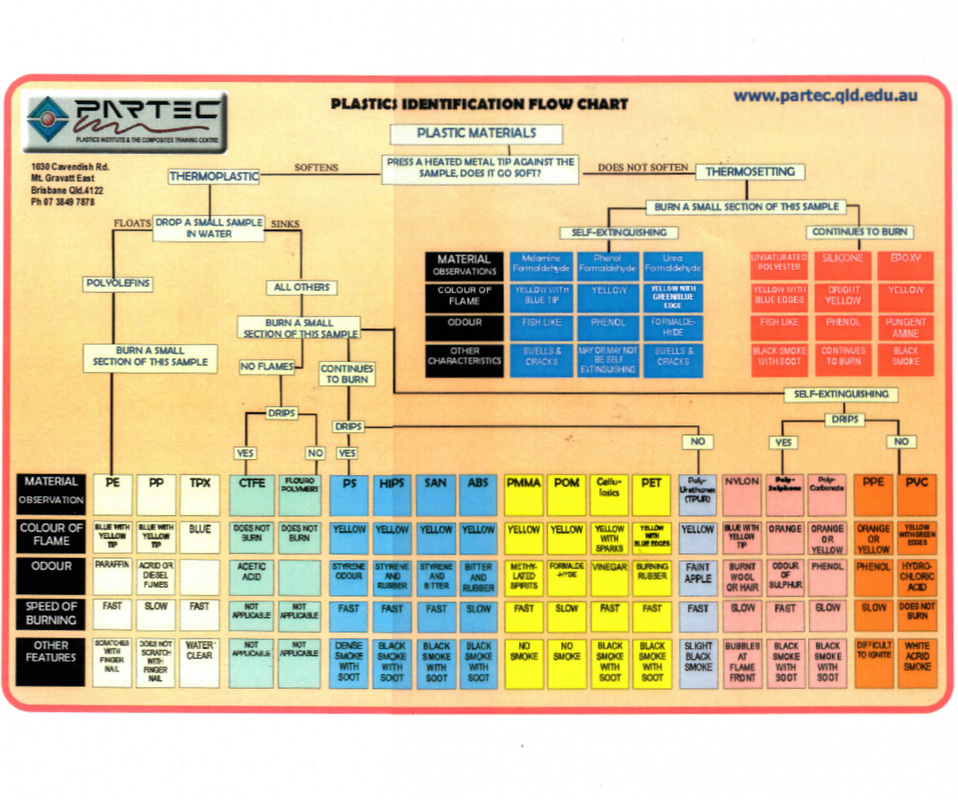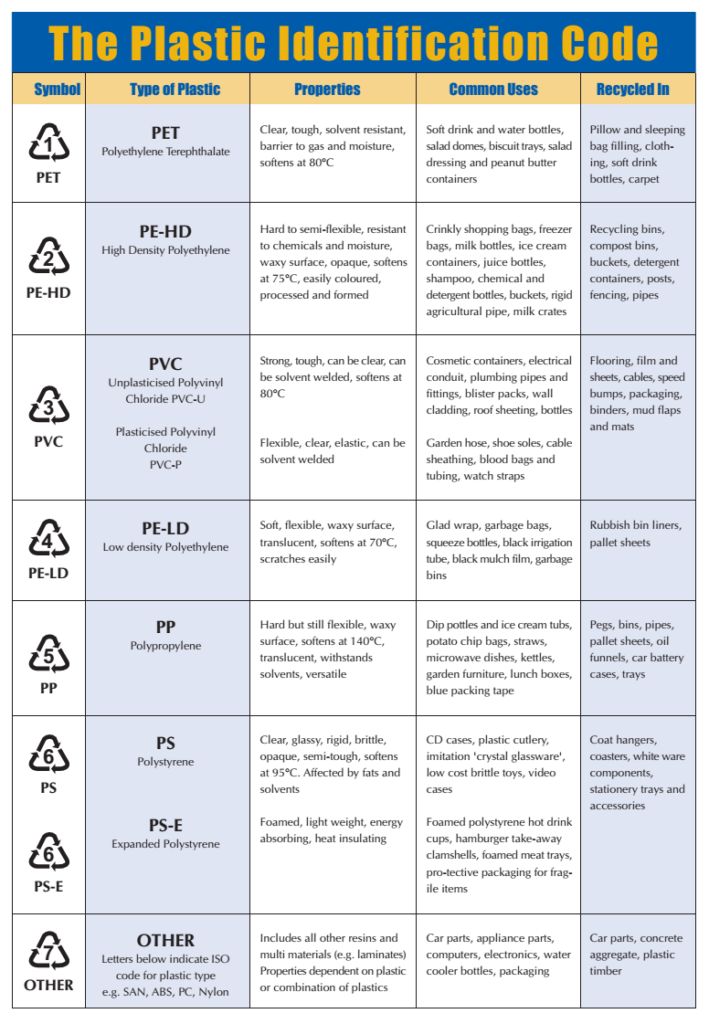Plastic Welding Materials come in many sizes and shapes, and are made for different welding techniques. There are many different materials, tools, and techniques to address different types of jobs. Please reach out to us for some guidance on how to fabricate or repair a particular part.
First step in any job is to identify the type of plastic you need to work with. This is extremely important, as the different plastic types are generally not cross-compatible. In other words, one plastic type does not stick or weld with a different type. You'll need to find and keep with the same type of plastic for your job.
Here are a few best-practices for identifying the plastic type you need:
- Look for the recycling code from 1 through 7 on the product to determine the parent material. (it's typically surrounded by that popular triangle-arrow shape)
- Look for letters that are enclosed between the greater-than and less-than symbols... for example: <ABS> <PP> <HDPE> <PVC> <LDPE> etc. This is typically located next to the part numbers for the part you are working with.
- Follow our flow chart to do a 'test burn' of the material to determine the melting point. This is a decent way to identify type of plastic, as they tend to melt at different temperature ranges.
- Purchase our Rod Test Kit to test for proper adhesion between the parent material and the rods provided. Be sure to follow our video on how to utilize the rod test kit
Polypropylene, ABS, HDPE, LDPE, PP and PVC are the most common base or parent materials used for plastic parts and thus the best to use for plastic welding. We offer all of these materials and more.
Sometimes LDPE (Low Density Polyethylene) can be used on HDPE (High Density Polyethylene) materials in certain applications.
Please review our chart below for help in selecting the proper shape and material type of welding rod for your application.
| Plastic Material | Welding / Melting Temp | |
| C / Celcius | F / Fahrenheit | |
| ABS | 350 | 662 |
| Acrylics | 350 | 662 |
| PC (Polycarbonate) | 350 | 662 |
| PA (Polyamides / Nylons) | 400 | 752 |
| Nylons ( aka PA Polyamides) | 400 | 752 |
| Polybutylene | 350 | 662 |
| PE - HDPE (Hi Density Polyethylene) | 300 | 572 |
| PE - LDPE (Low Density Polyethylene) | 270 | 518 |
| PP (Polypropylene) | 300 | 572 |
| PP (Polypropylene Rubber) | 300 | 572 |
| PUR (Polyurethane) | 300 | 572 |
| PVC HD (Polyvyinyl Cholride High Density) | 300 | 572 |
| PVC LD (Polyvyinyl Cholride Low Density) | 450 | 842 |


Also, below is a small sampling of the materials that we have worked with in the past in other applications for extrusion, plastic welding, plastic fabrication, vacuum forming and injection molding. Please note that not all of these materials have been tested for Plastic Welding and 3D printing applications and may or may not be available in our store.
Polypropylene (PP), Nylon 6/6, Nylon 6, Nylon 11, Nylon 6/12, Nylon 12, Polycarbonate (PC), Polystyrene, High Impact Polystyrene, Acrylonitrile Butadiene Styrene (ABS), Polyethylene (PE), Low Density Polyethylene (LDPE), High Density Polyethylene (HDPE), Acetal, Polysulfone, Thermoplastic Polyurethane, Polyphenylene Sulfide, Polyethersulfone, Acrylic, Polycarbonate / Acrylic Alloy, Custom Alloys, Polyetherimide, Polyetheretherketone, Polyetherketone, Polycarbonate/ABS Alloy, Thermoplastic Polyolefin Elastomer, Styrenic Block Copolymer Thermoplastic Elastomer, Polyvinyl Chloride (PVC), Liquid Crystal Polymer, Polyphthalamide, Hot Water Moldable Polyphthalamide, Polyetherketoneketone, High Temperature Nylon, Thermoplastic Elastomer, Polylactic Acid, PP, PA 6/6, PA 6, PA 6/10, PA 11, PA 6/12, PA, PA 12, PC, PS, HIPS, ABS, LDPE, HDPE, POM, PSU, PPS, PES, PMMA, PC/PMMA, PEI, PEEK, PEK, RTPU, PC/ABS, TEO, TES, PVC, LCP, PPA, PEKK, PLA
Material Safety Data Sheets, Processing Guidelines and Material Property Datasheets are available upon request for any of the above materials.
This information is intended to be used only as a guideline for designers and processors of modified thermoplastics. Because design and processing is complex, a set solution will not solve all problems. Observation on a “trial and error” basis may be required to achieve desired results.
Data are obtained from specimens molded under carefully controlled conditions from representative samples of the compound described herein. Properties may be materially affected by molding techniques applied and by the size and shape of the item molded. No assurance can be implied that all molded articles will have the same properties as those listed.
Disclaimers: No information supplied by Perigee Direct (Us, and We) constitutes a warranty regarding product performance or use. Any information regarding performance or use is only offered as suggestion for investigation for use, based upon Us or other customer experience. We make no warranties, expressed or implied, concerning the suitability or fitness of any of its products for any particular purpose. It is the responsibility of the customer to determine that the product is safe, lawful and technically suitable for the intended use. The disclosure of information herein is not a license to operate under, or a recommendation to infringe any patents.

